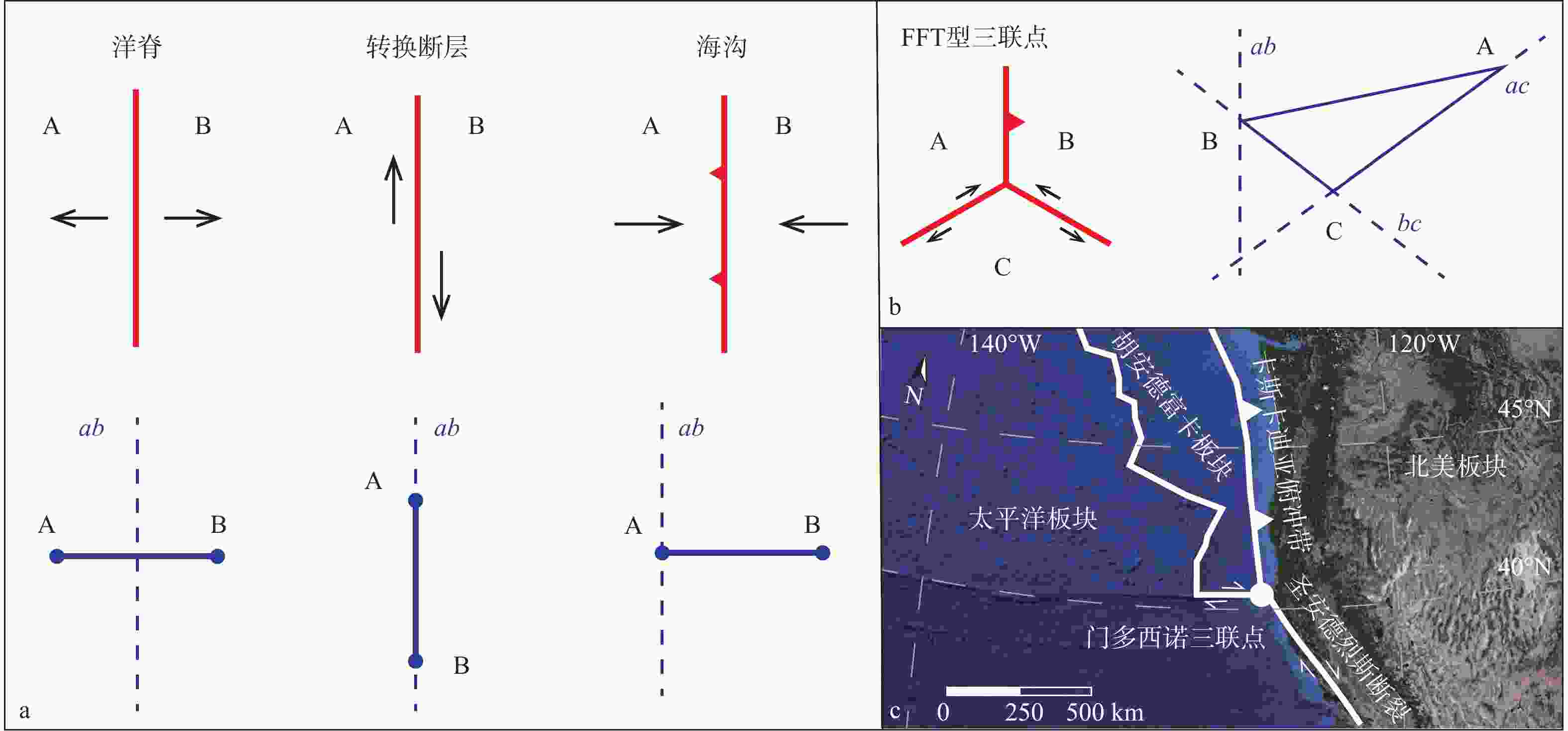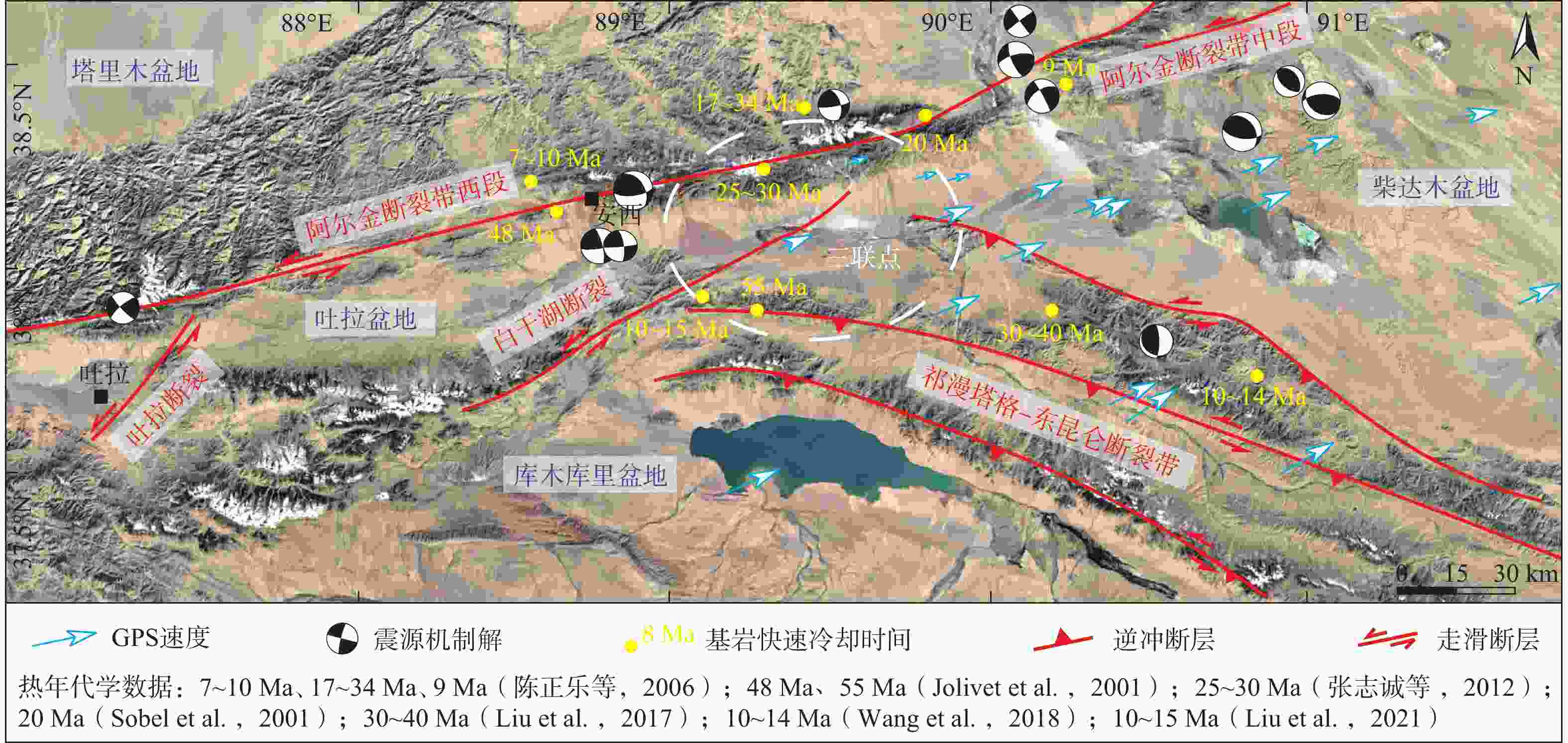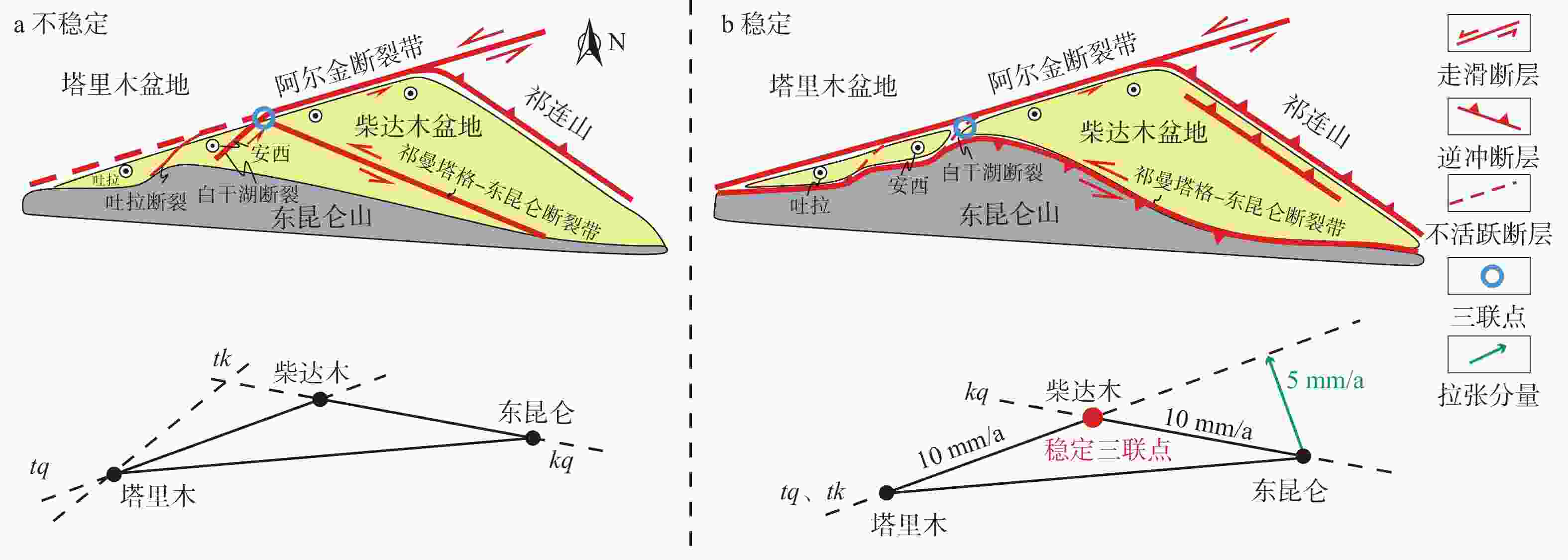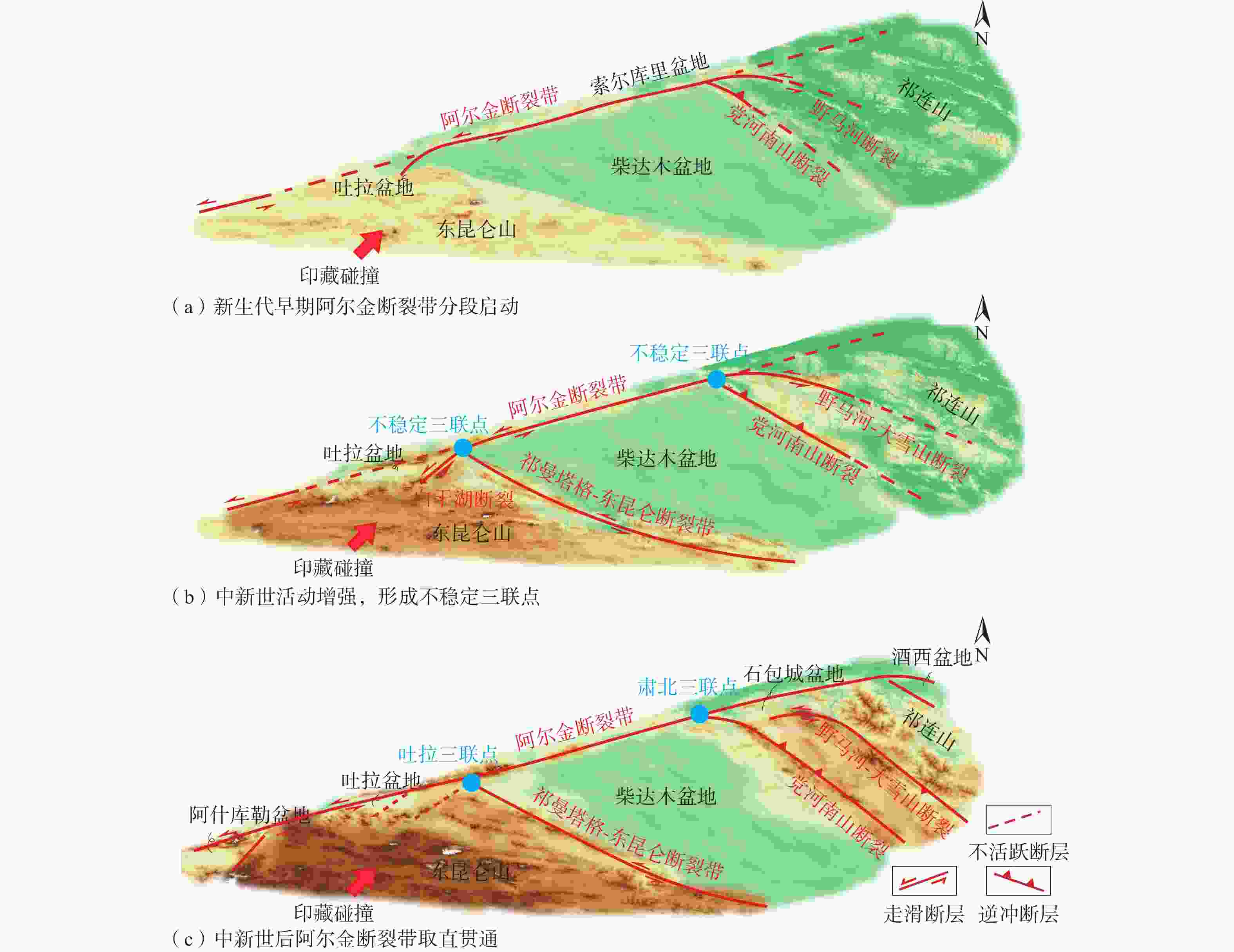Tectonic transition and extension at the eastern and western ends of the Altyn Tagh fault: insights from triple junctions
-
摘要: 阿尔金断裂带作为青藏高原北缘的关键构造边界,其演化历史和构造转换机制对理解青藏高原的生长极为重要。阿尔金断裂带不同分段的构造环境与演化历程不同,其各自与祁连山造山带和祁曼塔格−东昆仑断裂带的构造转换研究也仍有不足之处。三联点分析是板块构造学中的重要分析方法,速度三角形反映了断裂属性,三联点稳定性则从运动学角度揭示了断裂的演化方向和历程。综合地质、地貌与地震资料,系统分析了阿尔金断裂带中段与东西段代表性的肃北与吐拉三联点的构造特征与活动历史;并借助三联点稳定性准则,构建了这2个三联点的演化模型。研究结果表明,野马河−大雪山断裂与祁曼塔格−东昆仑断裂带启动,不稳定三联点形成并向稳定三联点转化,促使阿尔金断裂带“截弯取直”,并在此基础上提出了分段破裂−双向扩展模型。这一结果为理解青藏高原北缘复杂的构造演化历史提供了新的视角。Abstract:
Objective The Altyn Tagh fault (ATF) is the largest left-lateral strike-slip fault on the northern margin of the Qinghai-Tibet Plateau, extending for about 1600 km. It accommodates a considerable portion of the India-Eurasia convergence and is widely regarded as a key tectonic boundary influencing the plateau’s uplift and outward growth. However, its mode of propagation remains debated. Resolving this debate requires clarifying how the ATF evolved into its present configuration and how it connects with adjacent structures such as the Qilian orogenic belt and the Qimantagh-Eastern Kunlun fault. In this study, we use the concept of triple junctions to investigate key transition zones at the eastern and western ends of the ATF—namely, the Subei and Tula triple junctions—to shed light on the fault’s Cenozoic segmented rupture and bidirectional extension. Methods Triple junction analysis, a fundamental method in plate tectonics, is utilized to assess fault properties and fault stability from a kinematic perspective. Additionally, GPS data and seismic source mechanism solutions are analyzed to characterize the current kinematic behaviors and movement directions of the faults. Results (1) Transition between ATF and Qilian orogenic belt: Subei triple junction. The central segment of the ATF was the earliest to become active during the Cenozoic, generating a compressional horsetail splay on its eastern termination. The Danghe Nanshan fault and Yemahe-Daxueshan fault emerged as part of this horsetail splay. As left-lateral strike-slip motion on the ATF accelerated in the Miocene, large offsets developed between the Tarim, Qaidam, and Qilian blocks, giving rise to a triple junction near Subei. Initially, this triple junction was unstable, and the Qilian block experienced extensional strain relative to the Tarim block, indicating a local stretching environment. To achieve stability, the ATF progressively “straightened” eastward, ultimately supplanting the Yemahe-Daxueshan fault. Its western segment was reoriented to run parallel to the ATF, while the Danghe Nanshan fault remained as the key boundary on the Qilian side. Consequently, a stable triple junction formed at the intersection of the ATF’s central and eastern segments with the Danghe Nanshan fault. At the present leading edge of the ATF’s eastward propagation, the Hongliuxia fault displays a similar evolutionary trajectory, suggesting that the ATF continues to extend by reconfiguring secondary faults. (2) Transition between ATF and Qimantagh-Eastern Kunlun fault: Tula triple junction. The ATF’s central segment spawned a tensional horsetail splay at its western termination, involving the Tula and Baiganhu faults. When large-scale activity on the Eastern Kunlun fault commenced in the Miocene, the Qaidam block began moving relative to the Eastern Kunlun block, producing an unstable triple junction in the Tula region. To achieve a stable configuration, the ATF propagated westward along a more linear path, gradually diminishing activity on the Baiganhu fault. As a result, the stable triple junction—involving the Tarim, Qaidam, and Eastern Kunlun blocks—ultimately localized where the ATF meets the Qimantagh-Eastern Kunlun fault. This westward “straightening” and the concurrent reduction in subsidiary fault activity have fashioned the current tectonic framework at the western end of the ATF. Conclusion (1) The ATF has undergone a segmented rupture–bidirectional extension process throughout the Cenozoic. (2) The Miocene activation of the Yemahe-Daxueshan, the Qimantagh-Eastern Kunlun and other fault systems led to the formation of two triple junctions at Subei and Tula, respectively. These junctions were initially unstable, prompting secondary faults to “shortcut” and realign and leading the ATF to straighten and extend farther east and west. [Significance] This study refines our understanding of how the Altyn Tagh fault expanded along the northern margin of the Qinghai-Tibet Plateau. By applying triple junction concepts to continental blocks, we illustrate how block interactions have governed the ATF’s segmentation and through-going evolution. The proposed segmented rupture–bidirectional extension framework reconciles geological observations of Cenozoic deformation along the ATF. It also underscores the importance of analyzing triple junctions in understanding large-scale tectonic reorganization. -
图 1 阿尔金断裂带构造简图
a—青藏高原主要走滑断裂分布图;b—阿尔金断裂带受阻双弯曲、三联点与邻区主要断裂的位置关系分布图(WATF、MATF、EATF分别代指阿尔金断裂带西段、中段与东段);c—阿尔金断裂带地貌学与大地测量学研究获得的左旋走滑速率分布图(修改自Wu et al.,2019b)
Figure 1. Simplified tectonic map of the Altyn Tagh fault (ATF)
(a) Distribution of major strike-slip faults on the Qinghai-Tibet Plateau; (b) Extension of the ATF and its spatial relationships with neighboring major faults; the double bending, triple junctions, and the positions of the western, central, and eastern segments of the Altyn Tagh fault (WATF, MATF, and EATF, respectively) are shown;(c) Distribution of left-lateral strike-slip rates obtained from geomorphological and geodetic studies of the Altyn Tagh fault (modified from Wu et al., 2019b)
图 2 三联点原理示意图
A、B、C代表不同的板块;红色实线代表板块边界,蓝色虚线ab、bc、ac则代表板块AB、板块BC和板块AC之间的边界辅助线;ab、bc共线或者ac、bc共线时稳定a—三联点稳定性辅助线作法示意图;b—以FFT型三联点为例,说明三联点速度三角形及辅助线的作法,修改自McKenzie and Morgan(1969);c—Mendocino三联点(FFT型)( Ingersoll,1982)
Figure 2. Schematic diagram of triple junction principles
(a) Schematic diagram illustrating the method of constructing auxiliary lines for triple junction stability; (b) An FFT-type triple junction is used as an example for the construction of the triple junction velocity triangle and auxiliary lines, adapted from McKenzie and Morgan (1969); (c) Mendocino triple junction (FFT-type) (Ingersoll, 1982) In (a) and (b), A, B, and C represent different tectonic plates; the red solid lines denote plate boundaries, while the blue dashed lines ab, bc, and ac represent auxiliary boundary lines between Plate AB, Plate BC, and Plate AC, respectively. The triple junction is stable when ab and bc are collinear or when ac and bc are collinear.
图 4 肃北三联点稳定性演化示意图
速度矢量三角形中tq、tql、qql分别代表塔里木地块与柴达木地块、塔里木地块与祁连地块、柴达木地块与祁连地块的辅助线
Figure 4. Diagram of the stability evolution of the Subei triple junction
In the velocity vector triangle, tq, tql, and qql represent auxiliary lines connecting the Tarim and Qaidam blocks, the Tarim and Qilian blocks, and the Qaidam and Qilian blocks, respectively.
图 6 吐拉三联点稳定性演化示意图
速度矢量三角形中tq、tk、kq分别代表塔里木地块与柴达木地块、塔里木地块与东昆仑地块、东昆仑地块与塔里木地块的辅助线
Figure 6. Diagram of the stability evolution of the Tula triple junction
In the velocity vector triangle, tq, tk, and kq represent auxiliary lines connecting the Tarim and Qaidam blocks, the Tarim and Eastern Kunlun blocks, and the Eastern Kunlun and Qaidam blocks, respectively.
图 7 阿尔金断裂带与三联点演化示意图
Figure 7. Diagram of the evolution of the Altyn Tagh fault and triple junctions
(a) Early Cenozoic segmental initiation of the Altyn Tagh Fault (ATF); (b) Miocene activity enhancement, leading to the formation of unstable triple junctions; (c) Post-Miocene shortcutting and through-going of the ATF.
-
[1] AVOUAC J P, TAPPONNIER P, 1993. Kinematic model of active deformation in Central Asia[J]. Geophysical Research Letters, 20(10): 895-898. doi: 10.1029/93GL00128 [2] BIE L D, RYDER I, 2014. Recent seismic and aseismic activity in the Ashikule stepover zone, NW Tibet[J]. Geophysical Journal International, 198(3): 1632-1643. doi: 10.1093/gji/ggu230 [3] CHEN Z L, GONG H L, LI L, et al., 2006. Cenozoic uplifting and exhumation process of the Altyn Tagh mountains[J]. Earth Science Frontiers, 13(4): 91-102. (in Chinese with English abstract [4] CHENG F, JOLIVET M, FU S T, et al., 2014. Northward growth of the Qimen Tagh Range: a new model accounting for the Late Neogene strike-slip deformation of the SW Qaidam Basin[J]. Tectonophysics, 632: 32-47. doi: 10.1016/j.tecto.2014.05.034 [5] CHENG F, GUO Z J, JENKINS H S, et al., 2015a. Initial rupture and displacement on the Altyn Tagh fault, northern Tibetan Plateau: constraints based on residual Mesozoic to Cenozoic strata in the western Qaidam Basin[J]. Geosphere, 11(3): 921-942. doi: 10.1130/GES01070.1 [6] CHENG F, JOLIVET M, DUPONT-NIVET G, et al., 2015b. Lateral extrusion along the Altyn Tagh Fault, Qilian Shan (NE Tibet): insight from a 3D crustal budget[J]. Terra Nova, 27(6): 416-425. doi: 10.1111/ter.12173 [7] CHENG X, FU S T, WANG H F, et al., 2015c. Geometry and kinematics of the Arlar strike-slip fault, SW Qaidam basin, China: new insights from 3-D seismic data[J]. Journal of Asian Earth Sciences, 98: 198-208. doi: 10.1016/j.jseaes.2014.09.039 [8] CLARK M K, 2012. Continental collision slowing due to viscous mantle lithosphere rather than topography[J]. Nature, 483(7387): 74-77. doi: 10.1038/nature10848 [9] CLUBB F J, MUDD S M, HURST M D, et al., 2020. Differences in channel and hillslope geometry record a migrating uplift wave at the Mendocino triple junction, California, USA[J]. Geology, 48(2): 184-188. doi: 10.1130/G46939.1 [10] DICKINSON W R, SNYDER W S, 1979. Geometry of triple junctions related to San Andreas Transform[J]. Journal of Geophysical Research: Solid Earth, 84(B2): 561-572. doi: 10.1029/JB084iB02p00561 [11] DING L, KAPP P, CAI F L, et al., 2022. Timing and mechanisms of Tibetan Plateau uplift[J]. Nature Reviews Earth & Environment, 3(10): 652-667. [12] DONG Z Y, XIAO Q B, SUN Z L, et al., 2024. Crustal electrical anisotropic structure of the Altyn Tagh fault in the Subei Area, NW China: implications for fault zone architecture[J]. Journal of Geophysical Research: Solid Earth, 129(7): e2023JB028550. doi: 10.1029/2023JB028550 [13] DUVALL A R, CLARK M K, KIRBY E, et al., 2013. Low-temperature thermochronometry along the Kunlun and Haiyuan Faults, NE Tibetan Plateau: Evidence for kinematic change during late-stage orogenesis[J]. Tectonics, 32(5): 1190-1211. doi: 10.1002/tect.20072 [14] DZIEWONSKI A M, CHOU T A, WOODHOUSE J H, 1981. Determination of earthquake source parameters from waveform data for studies of global and regional seismicity[J]. Journal of Geophysical Research: Solid Earth, 86(B4): 2825-2852. doi: 10.1029/JB086iB04p02825 [15] EKSTRÖM G, NETTLES M, DZIEWOŃSKI A M, 2012. The global CMT project 2004-2010: Centroid-moment tensors for 13, 017 earthquakes[J]. Physics of the Earth and Planetary Interiors, 200-201: 1-9. doi: 10.1016/j.pepi.2012.04.002 [16] ELLIOTT J R, BIGGS J, PARSONS B, et al., 2008. InSAR slip rate determination on the Altyn Tagh Fault, northern Tibet, in the presence of topographically correlated atmospheric delays[J]. Geophysical Research Letters, 35(12): L12309. [17] ENGLAND P, MCKENZIE D, 1982. A thin viscous sheet model for continental deformation[J]. Geophysical Journal International, 70(2): 295-321. doi: 10.1111/j.1365-246X.1982.tb04969.x [18] FENG Z S, ZHANG Z C, LI J F, et al., 2010. Study on Cenozoic sedimentary characteristics and its relationship with the Altyn Tagh Fault in Shibaodan Basin, Gansu[J]. Chinese Journal of Geology, 45(1): 181-193. (in Chinese with English abstract [19] FURLONG K P, SCHWARTZ S Y, 2004. Influence of the Mendocino triple junction on the tectonics of coastal California[J]. Annual Review of Earth and Planetary Sciences, 32: 403-433. doi: 10.1146/annurev.earth.32.101802.120252 [20] GAO S B, COWGILL E, WU L, et al., 2022. From left slip to transpression: Cenozoic tectonic evolution of the North Altyn Fault, NW margin of the Tibetan Plateau[J]. Tectonics, 41(3): e2021TC006962. doi: 10.1029/2021TC006962 [21] GE W P, SHEN Z K, MOLNAR P, et al., 2022. GPS determined asymmetric deformation across central Altyn Tagh fault reveals rheological structure of Northern Tibet[J]. Journal of Geophysical Research: Solid Earth, 127(9): e2022JB024216. doi: 10.1029/2022JB024216 [22] GUO Z J, ZHANG Z C, 1998. Structural style and tectonic evolution of the basins in the Altun Region[J]. Geological Review, 44(4): 357-364. (in Chinese with English abstract [23] HARKINS N, KIRBY E, SHI X, et al., 2010. Millennial slip rates along the eastern Kunlun fault: implications for the dynamics of intracontinental deformation in Asia[J]. Lithosphere, 2(4): 247-266. doi: 10.1130/L85.1 [24] HE J K, VERNANT P, CHÉRY J, et al., 2013. Nailing down the slip rate of the Altyn Tagh fault[J]. Geophysical Research Letters, 40(20): 5382-5386. doi: 10.1002/2013GL057497 [25] HE P J, SONG C H, WANG Y D, et al., 2020. Early Cenozoic exhumation in the Qilian Shan, northeastern margin of the Tibetan Plateau: insights from detrital apatite fission track thermochronology[J]. Terra Nova, 32(6): 415-424. doi: 10.1111/ter.12478 [26] INGERSOLL R V, 1982. Triple-junction instability as cause for late Cenozoic extension and fragmentation of the western United States[J]. Geology, 10(12): 621-624. doi: 10.1130/0091-7613(1982)10<621:TIACFL>2.0.CO;2 [27] JOLIVET M, BRUNEL M, SEWARD D, et al., 2001. Mesozoic and Cenozoic tectonics of the northern edge of the Tibetan Plateau: fission-track constraints[J]. Tectonophysics, 343(1-2): 111-134. doi: 10.1016/S0040-1951(01)00196-2 [28] KIRBY E, HARKINS N, WANG E Q, et al., 2007. Slip rate gradients along the eastern Kunlun fault[J]. Tectonics, 26(2): TC2010. [29] LAW R, ALLEN M B, 2020. Diachronous Tibetan Plateau landscape evolution derived from lava field geomorphology[J]. Geology, 48(3): 263-267. doi: 10.1130/G47196.1 [30] LEVANDER A, HENSTOCK T J, MELTZER A S, et al., 1998. Fluids in the lower crust following Mendocino triple junction migration: active basaltic intrusion?[J]. Geology, 26(2): 171-174. doi: 10.1130/0091-7613(1998)026<0171:FITLCF>2.3.CO;2 [31] LI A, LIU R, ZHANG S M, et al., 2022. Evidence of structural transformation in the eastern part of the Altyn Tagh Fault, northern margin of the Tibetan Plateau, China, based on the kinematics and shortening rate of the Hongliuxia region[J]. Journal of Asian Earth Sciences, 240: 105445. doi: 10.1016/j.jseaes.2022.105445 [32] LI B S, YAN M D, ZHANG W L, et al., 2021. Bidirectional growth of the Altyn Tagh Fault since the Early Oligocene[J]. Tectonophysics, 815: 228991. doi: 10.1016/j.tecto.2021.228991 [33] LI C X, XU X W, WEN X Z, et al., 2011. Rupture segmentation and slip partitioning of the mid-eastern part of the Kunlun Fault, north Tibetan Plateau[J]. Science China Earth Sciences, 54(11): 1730-1745. doi: 10.1007/s11430-011-4239-5 [34] LI H B, YANG J S, SHI R D, et al., 2002. Determination of the Altyn Tagh strike-slip fault basin and its relationship with mountains[J]. Chinese Science Bulletin, 47(7): 572-577. doi: 10.1360/02tb9132 [35] LI H B, YANG J S, XU Z Q, et al., 2006. The constraint of the Altyn Tagh fault system to the growth and rise of the northern Tibetan plateau[J]. Earth Science Frontiers, 13(4): 59-79. (in Chinese with English abstract [36] LI J F, ZHANG Z C, ZHAO Y, et al., 2017. Detrital apatite fission track analyses of the Subei basin: implications for basin-range structure of the northern Tibetan Plateau[J]. International Geology Review, 59(2): 204-218. doi: 10.1080/00206814.2016.1219880 [37] LI Y C, SHAN X J, QU C Y, et al., 2018. Crustal deformation of the Altyn Tagh fault based on GPS[J]. Journal of Geophysical Research: Solid Earth, 123(11): 10309-10322. doi: 10.1029/2018JB015814 [38] LIN X, ZHENG D W, SUN J M, et al., 2015. Detrital apatite fission track evidence for provenance change in the Subei Basin and implications for the tectonic uplift of the Danghe Nan Shan (NW China) since the mid-Miocene[J]. Journal of Asian Earth Sciences, 111: 302-311. doi: 10.1016/j.jseaes.2015.07.007 [39] LIU C J, JI L Y, ZHU L Y, et al., 2024. Interseismic strain rate distribution model of the Altyn Tagh Fault constrained by InSAR and GPS[J]. Earth and Planetary Science Letters, 642: 118884. doi: 10.1016/j.jpgl.2024.118884 [40] LIU D L, LI H B, SUN Z M, et al., 2017. AFT dating constrains the Cenozoic uplift of the Qimen Tagh Mountains, Northeast Tibetan Plateau, comparison with LA-ICPMS Zircon U-Pb ages[J]. Gondwana Research, 41: 438-450. doi: 10.1016/j.gr.2015.10.008 [41] LIU D L, LI H B, CHEVALIER M L, et al., 2021. Activity of the Baiganhu Fault of the Altyn Tagh Fault System, northern Tibetan Plateau: insights from zircon and apatite fission track analyses[J]. Palaeogeography, Palaeoclimatology, Palaeoecology, 570: 110356. doi: 10.1016/j.palaeo.2021.110356 [42] LIU Y J, NEUBAUER F, GENSER J, et al., 2007. Geochronology of the initiation and displacement of the Altyn Strike-Slip Fault, western China[J]. Journal of Asian Earth Sciences, 29(2-3): 243-252. doi: 10.1016/j.jseaes.2006.03.002 [43] LU H J, SANG S P, WANG P, et al., 2022. Initial uplift of the Qilian Shan, northern Tibet since ca. 25 Ma: implications for regional tectonics and origin of Eolian deposition in Asia[J]. GSA Bulletin, 134(9-10): 2531-2547. doi: 10.1130/B36242.1 [44] LUO H, HE W G, YUAN D Y, et al., 2015. Slip Rate of Yema River-Daxue Mountain Fault since the Late Pleistocene and Its Implications on the Deformation of the Northeastern Margin of the Tibetan Plateau[J]. Acta Geologica Sinica-English Edition, 89(2): 561-574. doi: 10.1111/1755-6724.12447 [45] LUO H, XU X W, LIU X L, et al., 2020. The structural deformation pattern in the eastern segment of the Altyn Tagh fault[J]. Acta Geologica Sinica, 94(3): 692-706. (in Chinese with English abstract [46] MCKENZIE D P, MORGAN W J, 1969. Evolution of triple Junctions[J]. Nature, 224(5215): 125-133. doi: 10.1038/224125a0 [47] MENG Q R, HU J M, YANG F Z, 2001. Timing and magnitude of displacement on the Altyn Tagh fault: constraints from stratigraphic correlation of adjoining Tarim and Qaidam basins, NW China[J]. Terra Nova, 13(2): 86-91. doi: 10.1046/j.1365-3121.2001.00320.x [48] MÉTIVIER F, GAUDEMER Y, TAPPONNIER P, et al., 1998. Northeastward growth of the Tibet Plateau deduced from balanced reconstruction of two depositional areas: The Qaidam and Hexi Corridor basins, China[J]. Tectonics, 17(6): 823-842. doi: 10.1029/98TC02764 [49] MEYER B, TAPPONNIER P, BOURJOT L, et al., 1998. Crustal thickening in Gansu-Qinghai, lithospheric mantle subduction, and oblique, strike-slip controlled growth of the Tibet Plateau[J]. Geophysical Journal International, 135(1): 1-47. doi: 10.1046/j.1365-246X.1998.00567.x [50] MOLNAR P, ENGLAND P, MARTINOD J, 1993. Mantle dynamics, uplift of the Tibetan Plateau, and the Indian monsoon[J]. Reviews of Geophysics, 31(4): 357-396. doi: 10.1029/93RG02030 [51] PAN J W, LI H B, VAN DER WOERD J, et al., 2015. The first quantitative slip-rate estimated along the ashikule fault at the western segment of the Altyn Tagh fault system[J]. Acta Geologica Sinica-English Edition, 89(6): 2088-2089. doi: 10.1111/1755-6724.12621 [52] PATRIAT P, COURTILLOT V, 1984. On the stability of triple junctions and its relation to episodicity in spreading[J]. Tectonics, 3(3): 317-332. doi: 10.1029/TC003i003p00317 [53] PEI X, HUANGFU P P, LI Z H, et al., 2022. Why Qaidam Basin is amalgamated into Tibetan Plateau but Tarim basin is not?[J]. Chinese Journal of Geophysics, 65(11): 4259-4272. (in Chinese with English abstract [54] PELTZER G, TAPPONNIER P, 1988. Formation and evolution of strike-slip faults, rifts, and basins during the India-Asia Collision: an experimental approach[J]. Journal of Geophysical Research: Solid Earth, 93(B12): 15085-15117. doi: 10.1029/JB093iB12p15085 [55] SHAO Y X, YUAN D Y, OSKIN M E, et al., 2017. Historical (Yuan Dynasty) Earthquake on the North Danghe Nanshan Thrust, Western Qilian Shan, China[J]. Bulletin of the Seismological Society of America, 107(3): 1175-1184. doi: 10.1785/0120160289 [56] SHI W B, WANG F, YANG L K, et al., 2018. Diachronous growth of the Altyn Tagh mountains: constraints on propagation of the Northern Tibetan margin from (U-Th)/he dating[J]. Journal of Geophysical Research: Solid Earth, 123(7): 6000-6018. doi: 10.1029/2017JB014844 [57] SHOBE C M, BENNETT G L, TUCKER G E, et al., 2021. Boulders as a lithologic control on river and landscape response to tectonic forcing at the Mendocino triple junction[J]. GSA Bulletin, 133(3-4): 647-662. doi: 10.1130/B35385.1 [58] SOBEL E R, ARNAUD N, JOLIVET M, et al. , 2001. Jurassic to Cenozoic exhumation history of the Altyn Tagh range, northwest China, constrained by 40Ar/39Ar and apatite fission track thermochronology[C]//HENDRIX M S, DAVIS G A. Paleozoic and Mesozoic tectonic evolution of central and Eastern Asia: from continental assembly to intracontinental deformation. Boulder: Geological Society of America. [59] SONG C H, 2006. Tectonic uplift and Cenozoic sedimentary evolution in the northern margin of the Tibetan Plateau[D]. Lanzhou: Lanzhou University. (in Chinese with English abstract [60] SONG X D, LI J T, BAO X W, et al., 2015. Deep structure of major basins in Western China and implications for basin formation and evolution[J]. Earth Science Frontiers, 22(1): 126-136. (in Chinese with English abstract [61] STEIGERWALD L, EINARSSON P, HJARTARDÓTTIR Á R, 2020. Fault kinematics at the Hengill Triple Junction, SW-Iceland, derived from surface fracture pattern[J]. Journal of Volcanology and Geothermal Research, 391: 106439. doi: 10.1016/j.jvolgeores.2018.08.017 [62] SUN Y J, DONG S W, FAN T Y, et al., 2013. 3D rheological structure of the continental lithosphere beneath China and adjacent regions[J]. Chinese Journal of Geophysics, 56(9): 2936-2946. (in Chinese with English abstract [63] SUN Z M, YANG Z Y, PEI J L, et al., 2005. Magnetostratigraphy of Paleogene sediments from northern Qaidam Basin, China: Implications for tectonic uplift and block rotation in northern Tibetan Plateau[J]. Earth and Planetary Science Letters, 237(3-4): 635-646. doi: 10.1016/j.jpgl.2005.07.007 [64] TAPPONNIER P, PELTZER G, LE DAIN A Y, et al., 1982. Propagating extrusion tectonics in Asia: new insights from simple experiments with plasticine[J]. Geology, 10(12): 611-616. doi: 10.1130/0091-7613(1982)10<611:PETIAN>2.0.CO;2 [65] TAPPONNIER P, ZHIQIN X, ROGER F, et al., 2001. Oblique stepwise rise and growth of the Tibet Plateau[J]. Science, 294(5547): 1671-1677. doi: 10.1126/science.105978 [66] TIAN D, UIEDA L, LEONG W J, et al. , 2024. PyGMT: A Python interface for the Generic Mapping Tools[J/OL]. Zenodo, 2024-09. Available from: https://doi.org/10.5281/zenodo.13679420. [67] TIAN Q J, DING G Y, 1998. The tectonic feature of a quasi trijunction in the northeastern corner of Qinghai Xizang Plateau[J]. Earthquake Research in China, 14(4): 27-35. (in Chinese with English abstract [68] WANG E, XU F Y, ZHOU J X, et al., 2006. Eastward migration of the Qaidam basin and its implications for Cenozoic evolution of the Altyn Tagh fault and associated river systems[J]. GSA Bulletin, 118(3-4): 349-365. doi: 10.1130/B25778.1 [69] WANG M, SHEN Z K, 2020. Present-day crustal deformation of continental China derived from GPS and its tectonic implications[J]. Journal of Geophysical Research: Solid Earth, 125(2): e2019JB018774. doi: 10.1029/2019JB018774 [70] WANG W T, ZHANG P Z, PANG J Z, et al., 2016. The Cenozoic growth of the Qilian Shan in the northeastern Tibetan Plateau: a sedimentary archive from the Jiuxi Basin[J]. Journal of Geophysical Research: Solid Earth, 121(4): 2235-2257. doi: 10.1002/2015JB012689 [71] WANG X M, WANG B Y, QIU Z X, et al., 2003. Danghe area (western Gansu, China) biostratigraphy and implications for depositional history and tectonics of northern Tibetan Plateau[J]. Earth and Planetary Science Letters, 208(3-4): 253-269. doi: 10.1016/S0012-821X(03)00047-5 [72] WANG Y, 2001. Heat flow pattern and lateral variations of lithosphere strength in China mainland: constraints on active deformation[J]. Physics of the Earth and Planetary Interiors, 126(3-4): 121-146. doi: 10.1016/S0031-9201(01)00251-5 [73] WANG Y D, ZHENG J J, ZHENG Y W, 2018. Mesozoic-Cenozoic exhumation history of the Qimen Tagh Range, northeastern margins of the Tibetan Plateau: evidence from apatite fission track analysis[J]. Gondwana Research, 58: 16-26. doi: 10.1016/j.gr.2018.01.014 [74] WANG Z S, WEI D P, 2018. Research progress on the formation and evolution of triple junctions of global plate motions[J]. Progress in Geophysics, 33(5): 1834-1843. (in Chinese with English abstract [75] WU C, ZUZA A V, ZHOU Z G, et al., 2019a. Mesozoic-Cenozoic evolution of the Eastern Kunlun Range, central Tibet, and implications for basin evolution during the Indo-Asian collision[J]. Lithosphere, 11(4): 524-550. doi: 10.1130/L1065.1 [76] WU C, LI J, DING L, 2021. Low-temperature thermochronology constraints on the evolution of the Eastern Kunlun Range, northern Tibetan Plateau[J]. Geosphere, 17(4): 1193-1213. doi: 10.1130/GES02358.1 [77] WU L, LIN X B, COWGILL E, et al., 2019b. Middle Miocene reorganization of the Altyn Tagh fault system, northern Tibetan Plateau[J]. GSA Bulletin, 131(7-8): 1157-1178. doi: 10.1130/B31875.1 [78] XIE H, LIU C C, ZHANG H P, et al., 2022. Cenozoic evolution of the Altyn Tagh fault: evidence from sedimentary records of basins along the fault[J]. Acta Petrologica Sinica, 38(4): 1107-1125. (in Chinese with English abstract doi: 10.18654/1000-0569/2022.04.09 [79] XU Q, HETZEL R, HAMPEL A, et al., 2021. Slip rate of the Danghe Nan Shan thrust fault from 10Be exposure dating of folded river terraces: implications for the strain distribution in Northern Tibet[J]. Tectonics, 40(4): e2020TC006584. doi: 10.1029/2020TC006584 [80] XU X W, TAPPONNIER P, VAN DER WOERD J, et al., 2003. Late Quaternary sinistral slip rate along the Altyn Tagh fault and its structural transformation model[J]. Science in China (Series D), 33(10): 967-974. (in Chinese with English abstract [81] XU Z Q, YANG J S, ZHANG J X, et al., 1999. A comparison between the tectonic units on the two sides of the Altun Sinistral strike-slip fault and the mechanism of lithospheric shearing[J]. Acta Geologica Sinica, 73(3): 193-205. (in Chinese with English abstract [82] YAN B, CHEN P, GAO Y, 2024. Stepwise decrease in strike-slip rate along the eastern Altyn Tagh Fault and its relation to the Qilian Shan thrust system, northeastern Tibetan Plateau[J]. Journal of Structural Geology, 179: 105037. doi: 10.1016/j.jsg.2023.105037 [83] YANG Y Z, WANG Z D, LIU R C, et al., 2023. Evolution of kinematic transformation from the Altyn Tagh fault to the Qilian Shan in the northern Tibetan Plateau: from early Cenozoic initiation to mid-Miocene extrusion[J]. Frontiers in Earth Science, 11: 1250640. doi: 10.3389/feart.2023.1250640 [84] YECK W L, SHELLY D R, MATERNA K Z, et al., 2023. Dense geophysical observations reveal a triggered, concurrent multi-fault rupture at the Mendocino Triple Junction[J]. Communications Earth & Environment, 4(1): 94. [85] YI K X, CHENG F, YANG Y Z, et al., 2022. Pleistocene northward thrusting of the Danghe Nanshan: Implications for the growth of the Qilian Shan, Northeastern Tibetan Plateau[J]. Tectonophysics, 838: 229476. doi: 10.1016/j.tecto.2022.229476 [86] YI K X, CHENG F, JOLIVET M, et al., 2024. Carbonate U-Pb ages constrain Paleocene motion along the Altyn Tagh fault in response to the India-Asia collision[J]. Geophysical Research Letters, 51(8): e2023GL107716. doi: 10.1029/2023GL107716 [87] YIN A, RUMELHART P E, BUTLER R, et al., 2002. Tectonic history of the Altyn Tagh fault system in northern Tibet inferred from Cenozoic sedimentation[J]. GSA Bulletin, 114(10): 1257-1295. doi: 10.1130/0016-7606(2002)114<1257:THOTAT>2.0.CO;2 [88] YORK D, 1973. Evolution of Triple Junctions[J]. Nature, 244(5415): 341-342. doi: 10.1038/244341a0 [89] YU G, LI M, SHAO G L, et al., 2020. Electrical resistivity variations of lithospheric mantle beneath the northern Tibetan Plateau with tectonic implications[J]. Journal of Asian Earth Sciences, 198: 104273. doi: 10.1016/j.jseaes.2020.104273 [90] YU J X, ZHENG D W, PANG J Z, et al., 2019. Miocene range growth along the Altyn Tagh fault: insights from apatite fission track and (U-Th)/He thermochronometry in the Western Danghenan Shan, China[J]. Journal of Geophysical Research: Solid Earth, 124(8): 9433-9453. doi: 10.1029/2019JB017570 [91] YUE Y J, RITTS B D, GRAHAM S A, 2001. Initiation and long-term slip history of the Altyn Tagh fault[J]. International Geology Review, 43(12): 1087-1093. doi: 10.1080/00206810109465062 [92] ZANDT G, HUMPHREYS E, 2008. Toroidal mantle flow through the western U. S. slab window[J]. Geology, 36(4): 295-298. doi: 10.1130/G24611A.1 [93] ZHANG P Z, MOLNAR P, XU X W, 2007. Late Quaternary and present-day rates of slip along the Altyn Tagh Fault, northern margin of the Tibetan Plateau[J]. Tectonics, 26(5): TC5010. [94] ZHANG Z C, GUO Z J, LI J F, et al., 2012. Mesozoic and Cenozoic uplift-denudation along the Altyn Tagh fault, Northwestern China: constraints from apatite fission track data[J]. Quaternary Sciences, 32(3): 499-509. (in Chinese with English abstract [95] ZHUANG G S, JOHNSTONE S A, HOURIGAN J, et al., 2018. Understanding the geologic evolution of Northern Tibetan Plateau with multiple thermochronometers[J]. Gondwana Research, 58: 195-210. doi: 10.1016/j.gr.2018.02.014 [96] 陈正乐,宫红良,李丽,等,2006. 阿尔金山脉新生代隆升-剥露过程[J]. 地学前缘,13(4):91-102. doi: 10.3321/j.issn:1005-2321.2006.04.008 [97] 冯志硕,张志诚,李建锋,等,2010. 甘肃石包城盆地新生代沉积特征及与阿尔金断裂的关系研究[J]. 地质科学,45(1):181-193. doi: 10.3969/j.issn.0563-5020.2010.01.016 [98] 郭召杰,张志诚,1998. 阿尔金盆地群构造类型与演化[J]. 地质论评,44(4):357-364. doi: 10.3321/j.issn:0371-5736.1998.04.004 [99] 李海兵,杨经绥,许志琴,等,2006. 阿尔金断裂带对青藏高原北部生长、隆升的制约[J]. 地学前缘,13(4):59-79. doi: 10.3321/j.issn:1005-2321.2006.04.006 [100] 罗浩,徐锡伟,刘小利,等,2020. 阿尔金断裂东段的构造转换模式[J]. 地质学报,94(3):692-706. doi: 10.3969/j.issn.0001-5717.2020.03.002 [101] 裴旭,皇甫鹏鹏,李忠海,等,2022. 为何塔里木盆地独立于青藏高原整体变形之外而柴达木盆地却并入其中?[J]. 地球物理学报,65(11):4259-4272. doi: 10.6038/cjg2022P0429 [102] 宋春晖,2006. 青藏高原北缘新生代沉积演化与高原构造隆升过程[D]. 兰州:兰州大学. [103] 宋晓东,李江涛,鲍学伟,等,2015. 中国西部大型盆地的深部结构及对盆地形成和演化的意义[J]. 地学前缘,22(1):126-136. [104] 孙玉军,董树文,范桃园,等,2013. 中国大陆及邻区岩石圈三维流变结构[J]. 地球物理学报,56(9):2936-2946. doi: 10.6038/cjg20130908 [105] 田勤俭,丁国瑜,1998. 青藏高原东北隅似三联点构造特征[J]. 中国地震,14(4):27-35. [106] 王振山,魏东平,2018. 全球板块运动三联点形成与演化规律的研究进展[J]. 地球物理学进展,33(5):1834-1843. doi: 10.6038/pg2018BB0286 [107] 谢皓,刘彩彩,张会平,等,2022. 新生代阿尔金断裂带的演化:来自沿线盆地沉积记录的启示[J]. 岩石学报,38(4):1107-1125. doi: 10.18654/1000-0569/2022.04.09 [108] 徐锡伟,TAPPONNIER P,VAN DER WOERD J,等,2003. 阿尔金断裂带晚第四纪左旋走滑速率及其构造运动转换模式讨论[J]. 中国科学(D辑),33(10):967-974. [109] 许志琴,杨经绥,张建新,等,1999. 阿尔金断裂两侧构造单元的对比及岩石圈剪切机制[J]. 地质学报,73(3):193-205. doi: 10.3321/j.issn:0001-5717.1999.03.001 [110] 张志诚,郭召杰,李建锋,等,2012. 阿尔金断裂带中段中新生代隆升历史分析:裂变径迹年龄制约[J]. 第四纪研究,32(3):499-509. doi: 10.3969/j.issn.1001-7410.2012.03.16 -




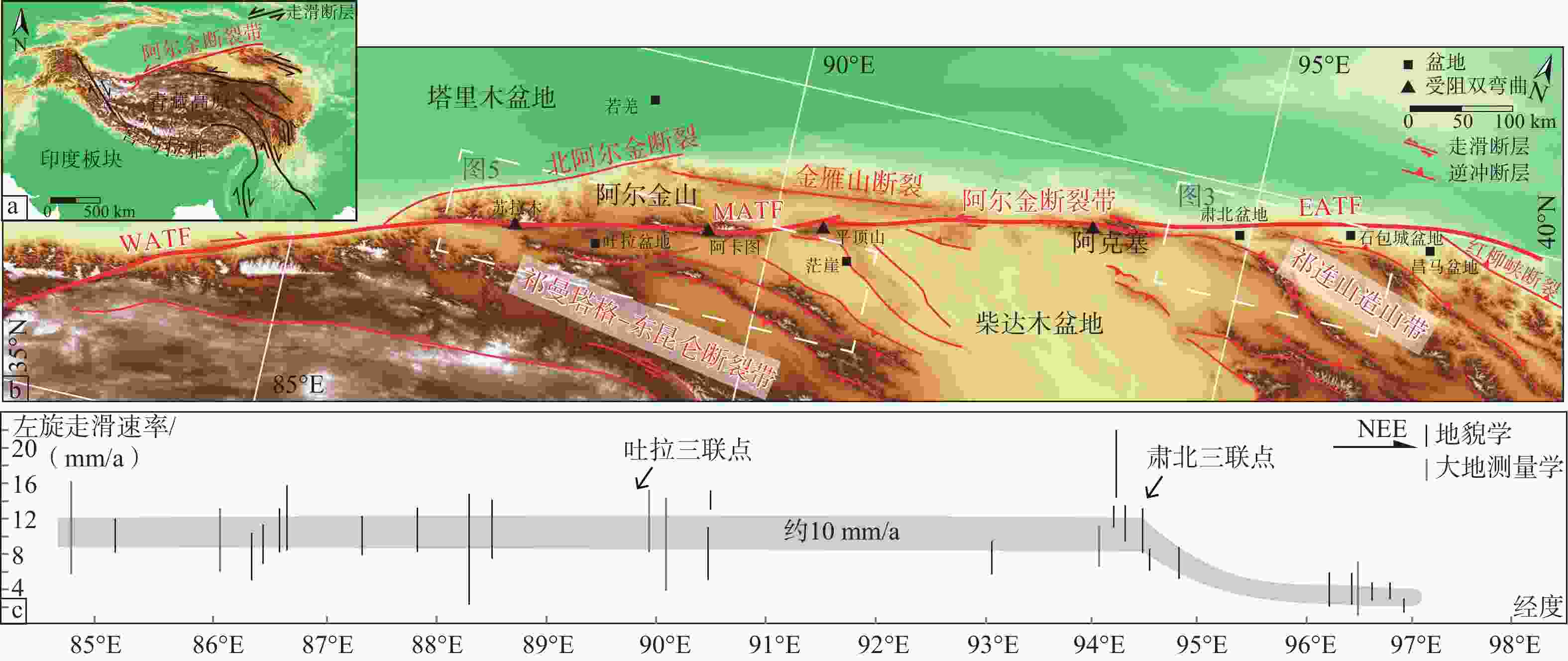
 下载:
下载:
